Overview

Bid Items; standard Treeview path: CMiC Field > Bid Management > Bid Items
Every project has its own set of bid items, as each project may have different purchase requirements for the same item. For example, the HVAC component may have been supplied and installed by the same contractor on one project, while on another project the equipment is being supplied separately from the installation contract. Creating a project bid item list is a process of selecting required items from the corporate bid item list and then adding any extra items as required or importing them from a spreadsheet.
In CMiC, each bid item can track a purchase method, estimate and target price, retainage percentage, the related specification document and sub-section, and the cost phase/category along with taxes. Items already purchased will show the actual purchase price.
The Alternate Identifier field is a numeric field with type: Number 4, 2 (i.e. a maximum of 4 characters including any decimal point, e.g. 44.1). The project role privilege ‘Maintain Bid items Alter ID Lov’ controls maintenance of the Alternate ID LOV, such as adding, editing or deleting alternative IDs (standard Treeview path: CMiC Field > Security > Project Roles).
The purpose of this field is to indicate that the bid item is an alternate for an existing item that can be selected by the owner if desired. Usually, these items are less costly options – a different grade of carpet, for example. The field is to be used for custom reporting purposes only. Field security can be applied to the Alternate Identifier, if necessary (standard Treeview path: CMiC Field > Security > Role Maintenance – Programs/Bid Items). The possible values are "Unrestricted", "Read-only", and "Hidden".
The [Copy Job Structure] button will allow creation of bid items from the phase/category structure of the current project's job. Display of this button can be set by field security.
The ability to configure the fields you want to see and to query particular records based on user input are features that the Bid Items screen afford as well.
Phase Type and Forecast Method for Bid Items
Phase Type and Forecast Method columns have been added to the Bid Items Sigma Grid.
The Phase Type column is validated against phase types (otherwise known as cost code types) set up on a company level in the Enter Cost Code Types screen in the Job Costing module (standard Treeview path: Job Costing > Setup > Local Tables > Enter Cost Code Types). New phase types can’t be created on the Bid Items screen. Any phase type other than the company defaults will produce an error.
The Forecast Method column is validated against standard forecast methods of amounts, productivity, and units. The forecast method entered can be overridden.
These two columns have also been added to the layout of the Bid Item Import file. Bid items manually entered or imported to the Bid Items screen will auto-populate the Phase Type and Forecast Methods columns, which can then be overridden.
Layout for Bid Item Import showing additional fields:
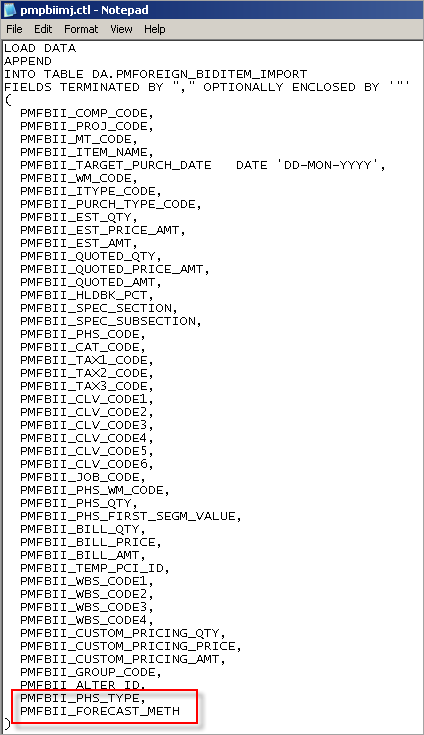
Bid Item Sigma Grid

Sigma Grid
The Sigma Grid allows users to directly modify Bid Item columns as they would with spreadsheets. There are a number of items at the bottom of the grid that allow adding, saving, deleting, and exporting to spreadsheet. There is also the ability to set the number of records to display per page.
The Add icon ( ) allows an input line to be opened up for adding a bid item.
) allows an input line to be opened up for adding a bid item.
The Resizing icon ( ) at the bottom-right corner of the grid allows re-sizing of the display area.
) at the bottom-right corner of the grid allows re-sizing of the display area.
The number of records per page can be modified and retained for an entire user session.
Configuring the Bid Items View
The Bid Items screen allows for a maximum of 50 pricing sets. A pricing set is defined as one column each of Qty, Price, and Amount fields plus a name and date.
[Pricing Sets] – Button
The [Pricing Sets] button replaces the original [Configure View], to give a pop-up of the various pricing sets that the user can create and/or select to show on the Bid Items screen.
![Example of pop-up window launched from the [Pricing Sets] button on the Bid Items screen](../../../../Resources/Images/7_Bid_Management/Bid_Item_Entry_Import_5_772x183.png)
Example of pop-up window launched from the [Pricing Sets] button on the Bid Items screen
The initial pop-up consists of the previously defined pricing sets: Pre-Estimate 1, Pre-Estimate 2, Estimate, Targeted, Actual, and Billing. These are set as system-defined and can’t be deleted.
Create and delete actions can be secured by using field security.
NOTE: User-defined pricing sets are project-specific.
[Configure View] – Button
The [Configure View] button displays a pop-up window of all the Bid Items screen’s fields from which the user can select which fields to show or not:
![Example of pop-up window launched from [Configure View] on Bid Items screen](../../../../Resources/Images/7_Bid_Management/Bid_Item_Entry_Import_6_769x477.png)
Example of pop-up window launched from [Configure View] on Bid Items screen
This is similar to the Log Builder, and also allows the user to select fields to be visible and/or locked. Lock means to freeze a column - it will be moved to the left side of the screen and frozen. The fields can also be moved to different positions.
The Pricing Set fields (including user-defined ones) can’t be locked but their position can be changed. They also are not editable on the Configuration screen.
The three Tax fields always go together and the Order# is calculated based on Tax1 position.
Field security can be applied to the [Configure View] button (standard Treeview path: CMiC Field > Security > Role Maintenance – Programs/Bid Items).
The Width field can be used to adjust the width of any column, as required. This includes setting the width for locked columns. A width can't be decreased beyond the minimum required value for that particular column. For some columns, the minimum width value is "40". For others, it is calculated by measuring the width of longest word in the column header. This requirement is in place to ensure that column headings are not being cut by width value in column configuration. If the width is less than the width of longest word in the heading, then the system will recalculate it.
[Save as Project Default] – Button
Clicking on the [Save as Project Default] button saves the configuration changes for the current project, for any user. Field security can be applied to the [Save as Project Default] button (standard Treeview path: CMiC Field > Security > Role Maintenance – Programs/Bid Items).
Querying Bid Items
To issue a query for retrieval of existing records, click the [Enter Query] button. This action causes a blue query line to appear just above the first bid item record of the current page.
![Example of pop-up window launched from [Enter Query] button on Bid Items screen](../../../../Resources/Images/7_Bid_Management/Bid_Item_Entry_Import_7.png)
Example of pop-up window launched from [Enter Query] button on Bid Items screen
The query is available on any field of the Bid Item.
For date fields, the format for query entry is dd-mm-yy, dd/mm/yy or dd-mmm-yyyy.
After entering the query values, click [Execute Query]. If any records exist which satisfy your input values, they will be displayed in the next screen display, and the title bar will show the word ‘filtered’.
To clear the query, press [Enter Query] again. You are brought back to the query input screen, on which the button [Clear Query] is available. Click this button to go back to view mode of the bid item list.
Adding & Editing Bid Items
![Example of pop-up window launched from [Add Bid Items] button on Bid Items screen](../../../../Resources/Images/7_Bid_Management/Bid_Item_Entry_Import_8.png)
Example of pop-up window launched from [Add Bid Items] button on Bid Items screen
While in View or Query Mode of bid items, you can create new bid items or edit existing ones by clicking [Add Bid Items] or by modifying the field directly.
The [Add Bid Items] button will display a list of Company Level Purchase Items (defined using Purchase Item Maintenance screen – program PMITEM), as long as the Phase field has been completed.
The Add icon ( ) at the bottom of the Sigma Grid will allow an input line to be opened up for adding a bid item.
) at the bottom of the Sigma Grid will allow an input line to be opened up for adding a bid item.
You can also delete selected records or ‘close’ items from being bid on/purchased.
If a bid item was bought through a purchase order or subcontract, it is automatically checked as ‘Closed’. If a user then tries to change this setting, a warning will be issued and the user will be given the option to proceed with the change or not. No warning is issued if the bid item was simply marked as closed, manually.
The [Recalc Totals] button saves changes and reloads the Sigma Grid with recalculated total lines. The reason for having a separate button rather than modifying the save functionality is the performance – a full reload requires much more time and computing resources than the quick/lightweight Ajax call.
Importing Bid Items
The importation of bid items, for bid jobs as well as actual jobs, from an external source (usually a spreadsheet) can be done while in edit or view mode. Refer to the Import Utilities guide for instructions on this.
Billing Type has been added to Bid Items Import. Field security can be applied to this field. It also includes the Alternate Identifier field.
When Phase Segmentation is being used for Bid Item Import and the first segment is under consideration, the phase code is validated accordingly on the Bid Item Import Validation screen.
NOTE: The 'Update Existing Bid Items' Import box is unchecked by default. With this default setting, new bid item records will be created for task codes that already exist as bid items (or duplicated in the import file) unless the user overrides the default and sets it to ‘checked’, to update existing bid items that match the task code of the items being imported.
Updating the Budget with Bid Items
![Example of pop-up window launched from Update Budget] button on Bid Items screen](../../../../Resources/Images/7_Bid_Management/Bid_Item_Entry_Import_9.png)
Example of pop-up window launched from [Update Budget] button on Bid Items screen
As your project grows, you can keep your project cost budget updated by using the [Update Budget] button at appropriate intervals. The function gives multiple methods of updating the associated job budget. The checkbox in PM Control, ‘Phase Description Taken From Bid List Item’, will update any new budget line with a description from the project bid item rather than the phase master.
When the [Update Budget] button is pressed, a small window will appear asking how you wish to update the job cost budget or revenue budget and with which numbers: Pre-Estimate, Estimate, Target or Actual. Select the update options required and press [Proceed].
Updating the Budget with Carry Value – Checkboxes
The carry value is stored on the corresponding bid item if there is a one-to-one relation between buyout item and bid item.
When updating budget from the Bid Items screen (using [Update Budget], two checkboxes allow the user to override budget and revenue amount by the carry value if it exists.
Field security can be applied to these checkboxes, if required. The possible values are "Unrestricted" or "Hidden".
Exclude Non Budgeted Categories – Checkbox
This checkbox indicates if bid items with non-budget categories should be excluded when updating the budget. By default, the box is unchecked. When checked, bid items with non-budget categories will be excluded when the budget is being updated using the [Update Budget] button.
Creating JB Contract in the Budget Update
The [Create Contract] button allows the creation of Job Billing (JB) contract for the current project job. It is a requirement that the retainage code be set up at the job or customer level, and all other pre-requisites for creating the JB contract be satisfied before this feature can be used successfully.
You need to select all the bid item lines that you need to create the JB contract bill-codes (based on job/phase/category), otherwise any phase/category combinations that are not included in the JB contract at this point will need to be added in the JB contract using the Add New Billcodes feature in the Job Billing module.
If the job already has a contract, the [Create Contract] will be disabled. The [Create Contract] button changes to [Update Contract] once the Job Billing contract is created so field security applies to both.
Bid Item and Budget Update for Lump-sum and Expense Authorization Projects
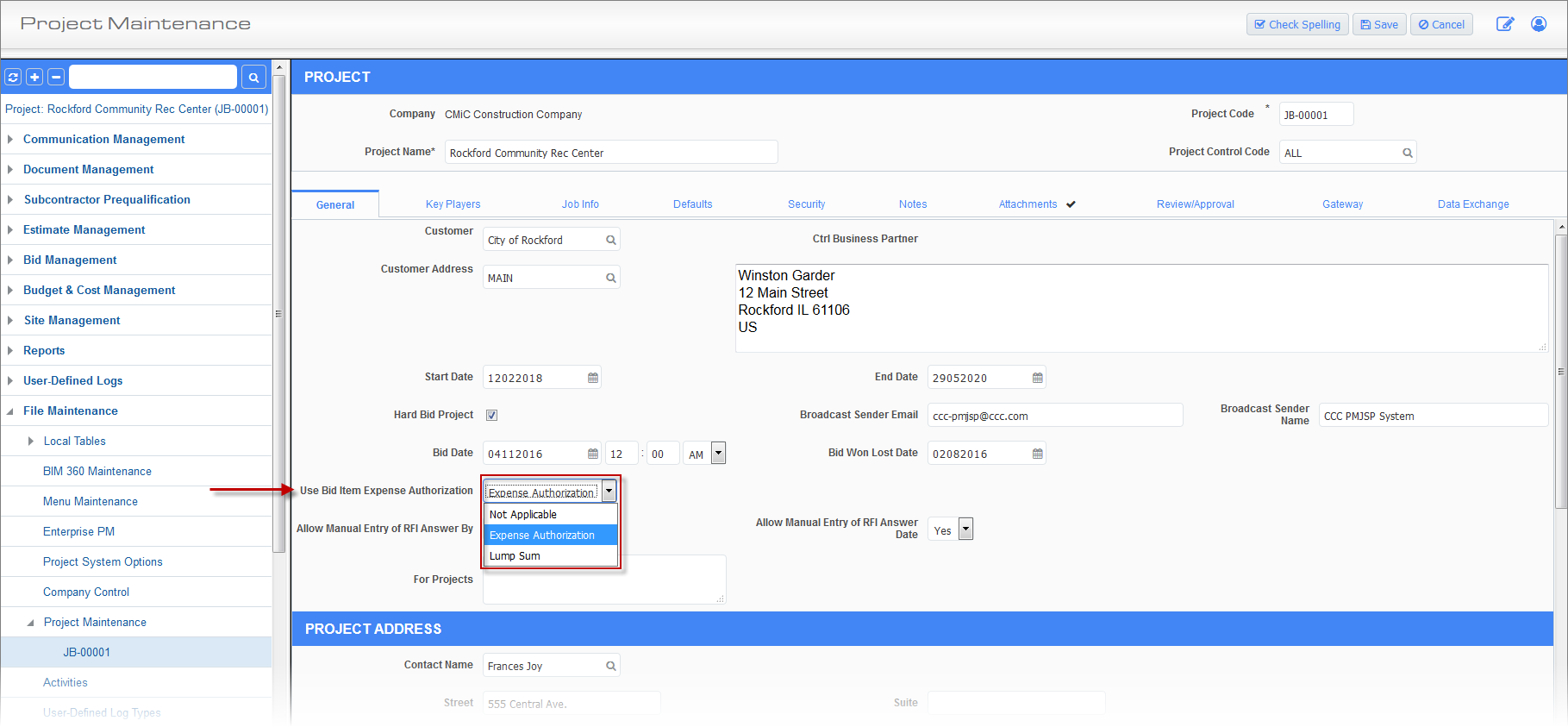
Project Maintenance; standard Treeview path: CMiC Field > File Maintenance > Project Maintenance
The Expense Authorization checkbox is now a drop-down box with three options: "Not Applicable", "Lump-Sum" and "Expense Authorization". The default is set at the Company Control level but can be overridden on the project.
-
Not Applicable – (to maintain standard functionality)
-
Expense Authorization (for current EA function)
-
Lump Sum
The selection made at the company level determines the default value of the project level option. The value can be overridden at the project level.
Lump Sum
When the "Lump Sum" option is selected, the following apply:
-
Bid items included in a budget update would not be editable after the budget was updated.
-
Bid items that were not selected for budget update would not be available in LOV on bid items button on subcontract or subcontract change order, except in the following cases:
-
Bid items that are linked to a posted PCI will always be available to select into an SC or SCCO.
-
Breakout bid items (created from a partial purchase) would be available to select into an SC or SCCO (they would always come from a bid item that was part of the budget update or a posted PCI).
-
-
Analyze Bids (Buyouts): When the 'Select' box is checked for a bid item that is not available, the message "Related Bid Item is not included in the budget" is displayed.
Expense Authorization
When the "Expense Authorization" option is selected, previously programmed changes for expense authorization still apply, but additionally, further validation has been programmed so that bid items not linked to a posted PCI will not be available for selection into a Subcontract or Subcontract Change Order.
Budget Update Column in Bid Items
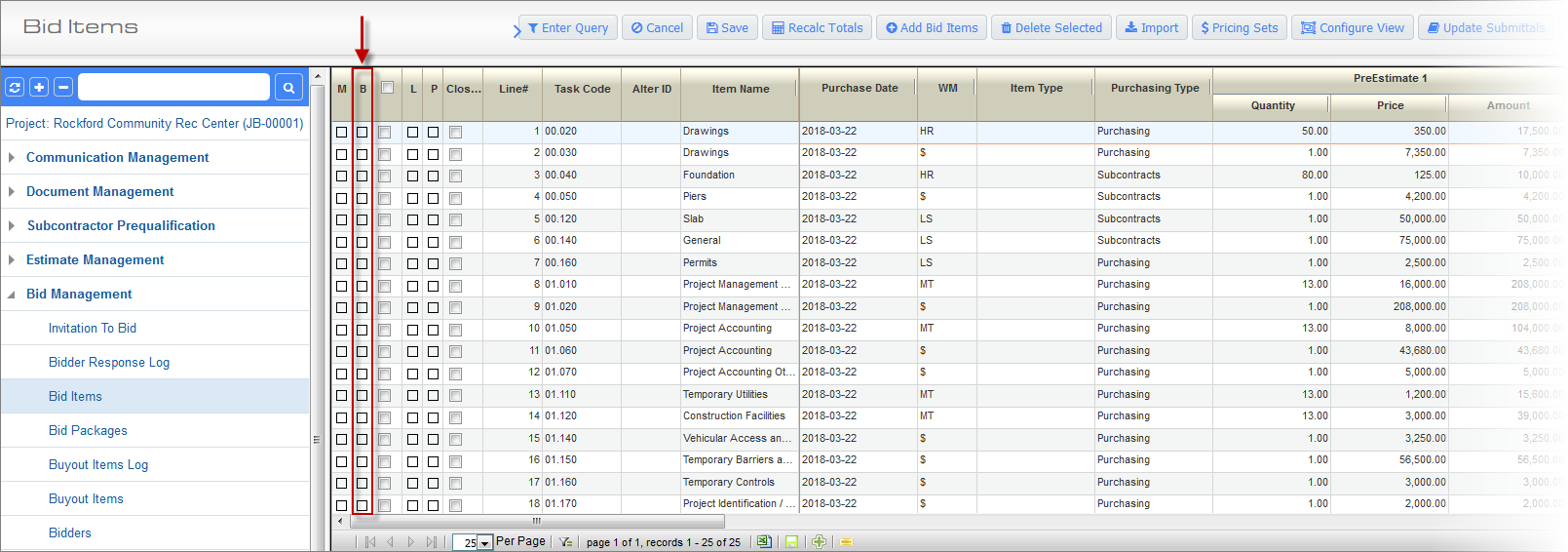
Bid Items; standard Treeview path: CMiC Field > Bid Management > Bid Items
The Budget Updated column is only updated by the system whenever a bid item has been used to update the budget (via the Update Budget feature). After the update (for lump-sum and expense authorization projects), the bid item is locked from further updates, and the fields are disabled from editing.
Variance On-The-Fly between Selected Pricing Sets
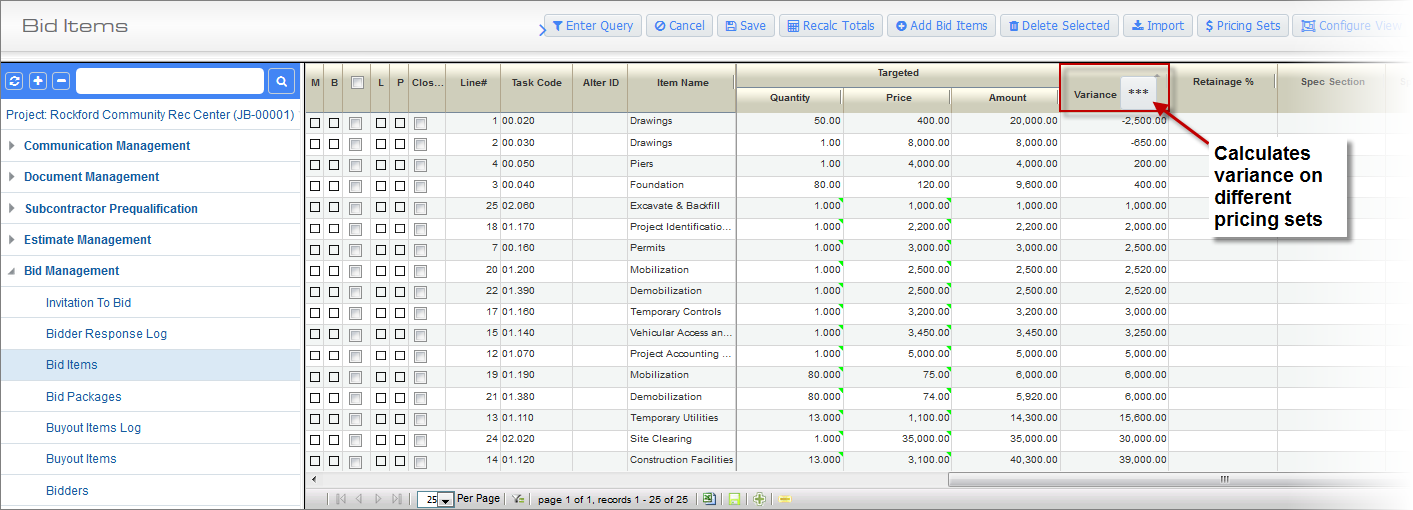
Bid Items; standard Treeview path: CMiC Field > Bid Management > Bid Items
The [•••] button beside the Variance column in Bid Items is used to calculate the variance on-the-fly between 2 selected pricing sets. The button is shown only when the Variance column is selected as a field for the screen (using the [Configure View] button).
When the button is clicked, a pop-up window is displayed for the user to select the two key figures they want the variance calculated for.
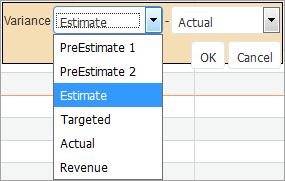
Example of Variance column's pop-up window
The calculated value of the variance will remain throughout the time the user is in the Bid Item screen, unless the two key figures are changed by the user.
Creating Submittals from Bid Items
You can create submittals from bid items by clicking the [Update Submittals] button. This button is enabled by the Project Role privilege 'Update Submittals from Bid Item screen'. Only users with PM Roles that have this privilege set will be able to create submittals from bid items. The button is available in both view and edit modes.
When the button is pressed, a message appears detailing how many Submittals are about to be created and/or updated via the [Update Submittals] process, so that the user can choose to proceed or not.
Bid Item Markups
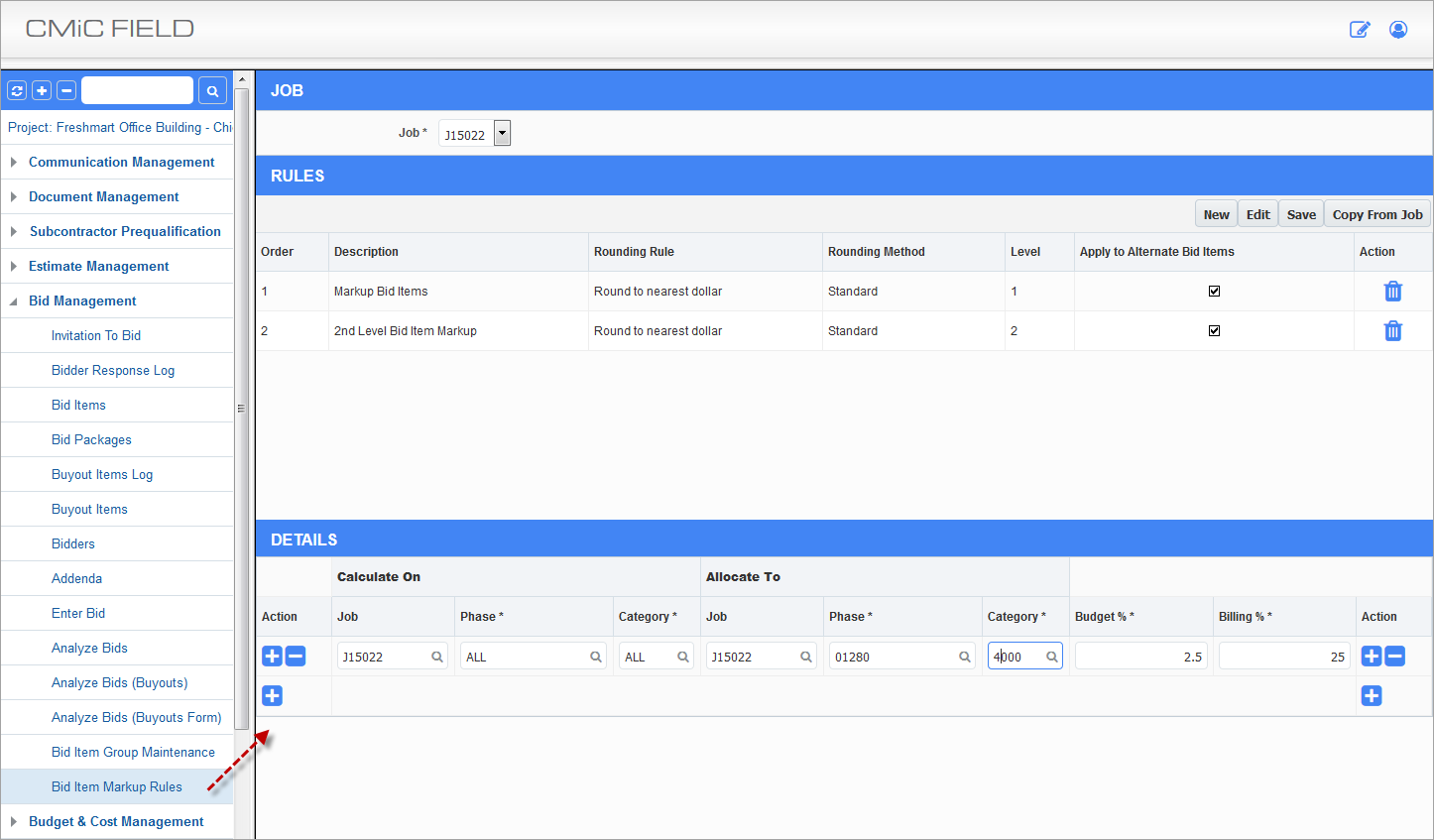
Standard Treeview path: CMiC Field > Bid Management > Bid Item Markup Rules
This screen allows the definition of markup rules/calculations which will be generated for all bid item records based on the markup % values in the markup definitions.
Security access to the program menu item is found under Assign Menu Items for the user or user role: ‘Bid Item Markup Rules’.
The ability to Create, Edit and Copy Bid Items Markup rules is also controlled by the ‘Markup Rules – Edit’ privilege.
The [Copy From Job] button allows the user to copy bid items markup rules from a source job to the current job. The Source Job LOV for the Copy only shows jobs that have bid items and have markup rules defined.
The system privilege “PMMRALLJOB: Allows user to create markup rules for ALL jobs”, is also used (in addition for PCI Markup rules), to determine if a user can create bid item markup rules for all jobs or not. If it is checked for the user, ‘ALL’ will be an option in the Job LOV of the Bid Item Markup maintenance screen.
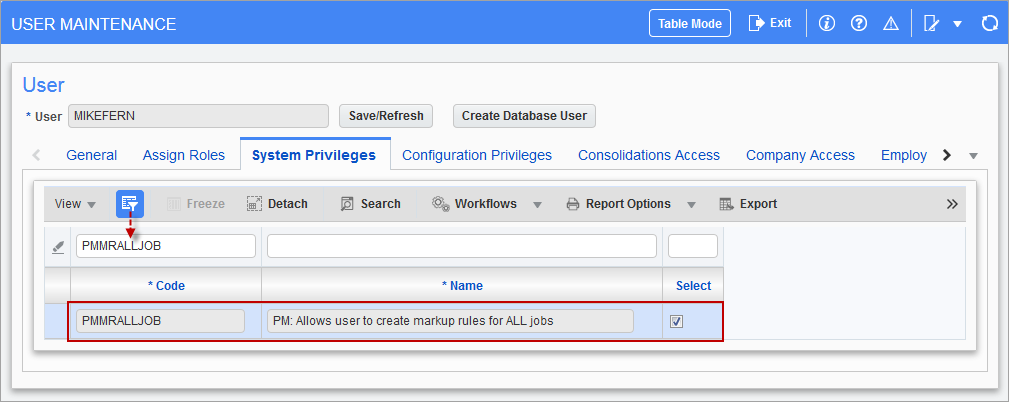
User Maintenance; standard Treeview path: CMiC Field > Security > User Maintenance
On the Bid Items screen, the [Calculate Markups] button is used to generate the markups defined. When completed, the M column becomes checked, and the markup lines are displayed in an orange color:
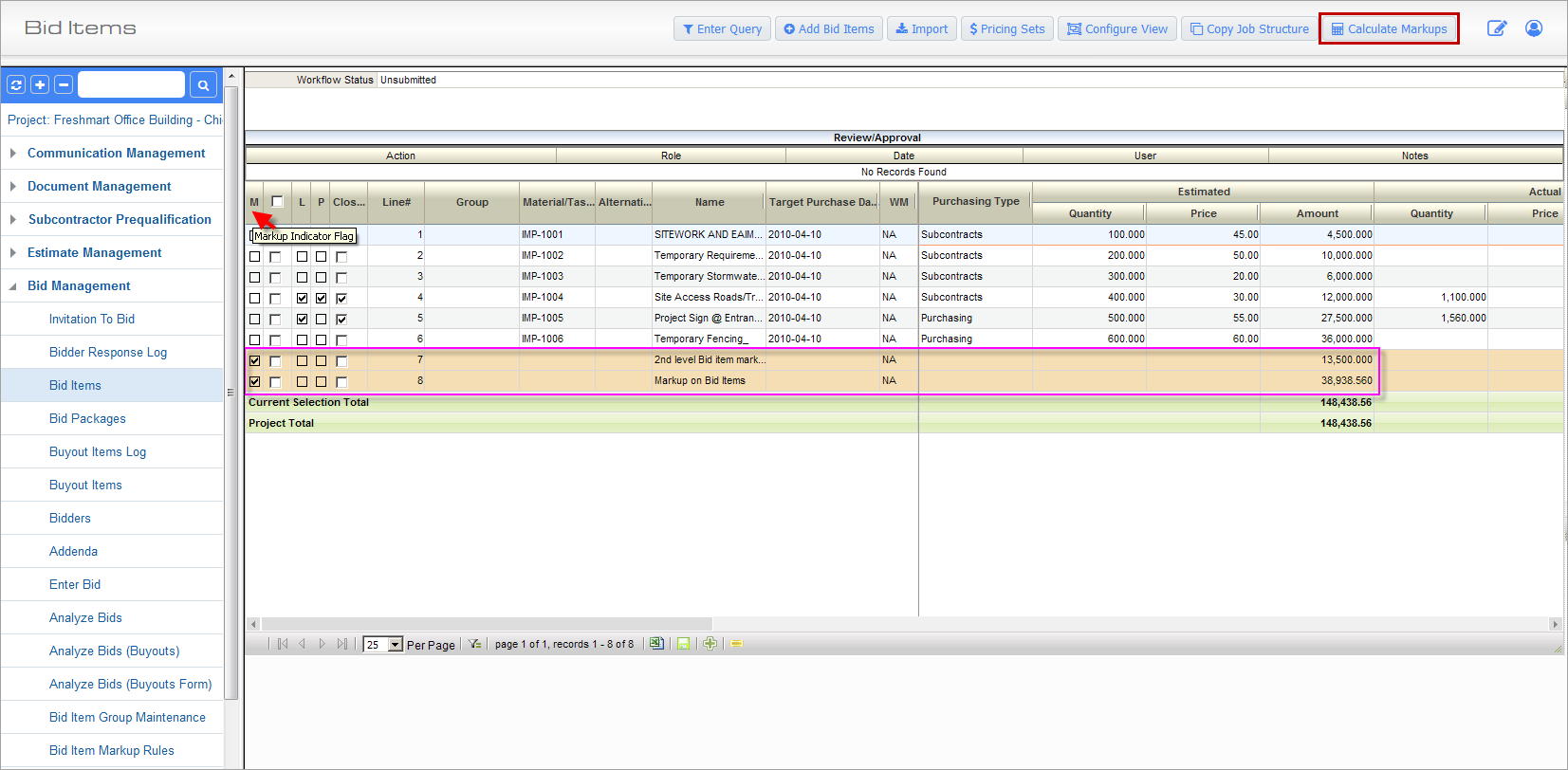
Bid Items; standard Treeview path: CMiC Field > Bid Management > Bid Items
Bid Item Markups for Alternate Lines
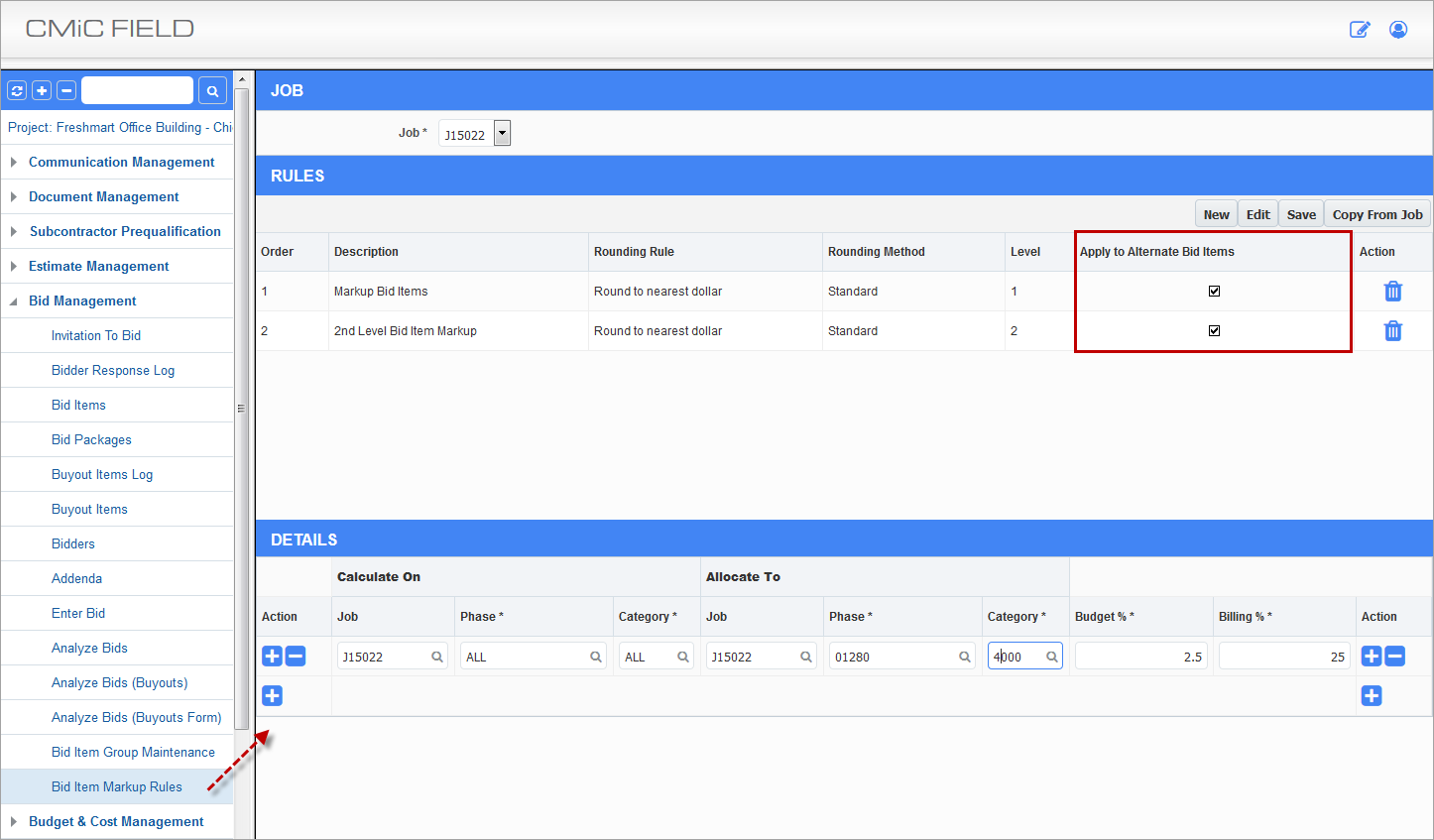
Standard Treeview path: CMiC Field > Bid Management > Bid Item Markup Rules
The ‘Apply to Alternate Bid Items’ checkbox indicates that markups are to be calculated on alternates as well. The Alternate ID field in the Bid Item screen needs to be populated as a pre-requisite.

Bid Items; standard Treeview path: CMiC Field > Bid Management > Bid Items
Bid Item Group Maintenance
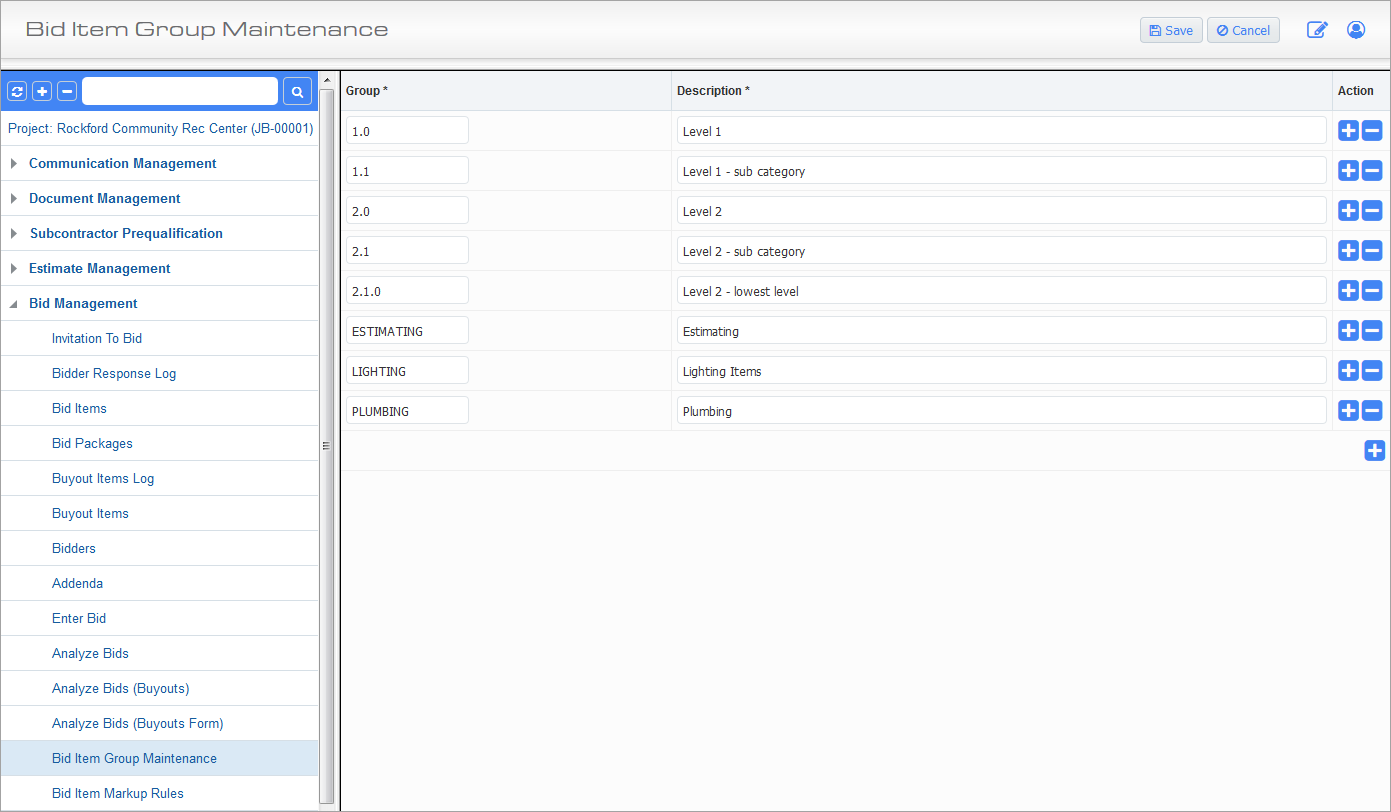
Bid Item Group Maintenance; standard Treeview path: CMiC Field > Bid Management > Bid Item Group Maintenance
This is a maintenance screen for project-specific bid item groups, to allow grouping of bid items for reporting purposes. Code and Description are the fields to be completed.